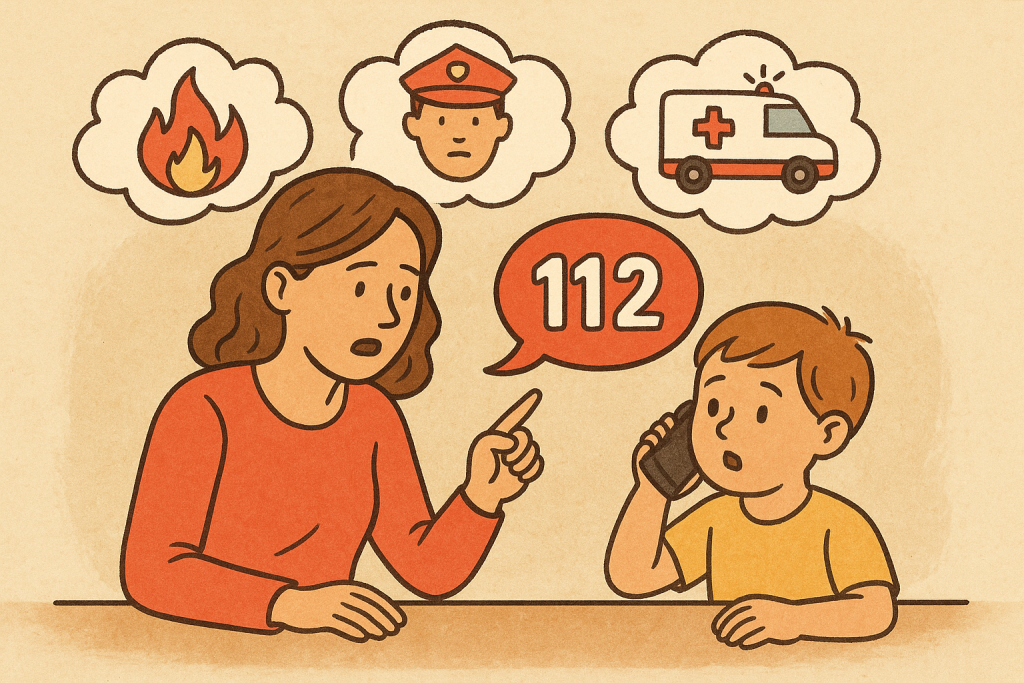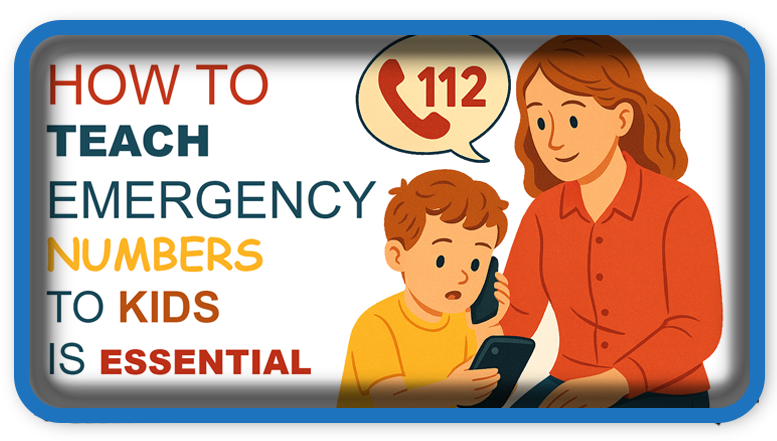⏲️ Estimated reading time: 5 min
In an emergency, knowing how to dial numbers can save lives. It’s crucial for every child to know what number to call and how to communicate in a crisis. Here’s why and how to teach them.
Why It’s Essential to Teach Your Child Emergency Numbers and How to Call Them
We live in an unpredictable world where our children’s safety must always come first. One of the most powerful tools a parent can provide is the knowledge of emergency phone numbers. A simple call to 911 (or 112 in the EU) can mean the difference between life and death. But teaching a child when, how, and why to dial these numbers requires care, consistency, and age-appropriate communication.
1. What Are Emergency Numbers?
Emergency numbers are special phone lines that can be called for free, 24/7, to request immediate help from emergency services police, ambulance, or fire department. In most European countries, the universal emergency number is 112, while in the United States, it’s 911.
Your child should understand that these numbers are only for real emergencies, such as:
- Car accidents
- Fires
- Unconscious or seriously injured individuals
- Crimes in progress or serious threats

2. Why It’s Important for Children to Know These Numbers
a. Every Second Counts
In life-threatening situations, every second matters. If an adult is unable to call for help due to injury or unconsciousness a child might be the only one who can take action.
b. Reduces Panic in a Crisis
Knowledge creates confidence. When a child knows exactly what to do in an emergency, they’re less likely to panic. Instead, they can focus on solving the problem or seeking help calmly.
c. Protecting Themselves and Others
Children can find themselves in unexpected situations at school, on the street, or even alone at home. If they know how to call for help, they can protect themselves and others around them.
3. When Should You Start Teaching?
The ideal time to start teaching a child about emergency numbers is around age 4 or 5 a time when they begin to grasp concepts like danger, responsibility, and rules. Make sure to keep the conversation light but informative, and repeat the lesson regularly.
4. How to Teach a Child to Call Emergency Services
a. Use Simple, Clear Explanations
Tell them what the emergency number is and in what situations it should be used. Avoid scaring them your tone should be calm and positive. For example:
“If mommy or daddy can’t wake up, if you see smoke, or someone is badly hurt and not getting up you call 112 (or 911).”
b. Show Them How to Use the Phone
Walk them through the process of making a call, even from a locked phone. Show how to press “Emergency Call” and what buttons to press.
Explain what to say during the call:
- Who they are – full name
- Where they are – exact address or location
- What happened – a short description of the situation
c. Practice With Role-Playing
Create pretend emergency scenarios and practice calling. You play the operator, and they explain the emergency. Try examples like:
- “Grandma fell and won’t wake up”
- “There’s a fire in the house”
- “I saw someone with a weapon”
Repetition helps build confidence and memorization.
d. Display Important Info in a Visible Spot
Write down and post the following in a visible place like the refrigerator:
- Child’s full name
- Home address
- Emergency number (112/911)
- Parents’ phone numbers

5. Common Mistakes to Avoid
- Fake or prank calls: Make it clear that calling 112/911 as a joke is illegal and could delay help for real emergencies.
- Unsupervised phone use: Keep an eye on phone usage and teach responsibility.
- Incorrect information: Regularly review your child’s knowledge of their name and address.
6. What Else Should They Know?
a. How to Describe Their Location
If the child is away from home, teach them how to spot landmarks and signs like:
- Street names or nearby stores
- Parks, churches, or schools
b. How to Stay Calm
Reassure them that emergency operators are there to help and won’t be angry if they make a mistake. It’s better to call than to freeze.
c. Emergency Workers Are Helpers
Children should never fear police officers, firefighters, or paramedics. Help them see these figures as protectors and friends.
7. Get Support From Teachers and Schools
Schools and kindergartens can reinforce these lessons. Many organize drills or invite emergency personnel for demonstrations. Encourage your child to participate and ask questions.
8. Resources to Help Parents
- Educational mobile apps like “112/911”
- YouTube videos made for children
- Storybooks or cartoons about safety and emergencies
Teaching your child how to call emergency numbers isn’t just smart it’s a critical life skill. Done right, it can turn fear into confidence, hesitation into action, and uncertainty into safety. It may even save a life perhaps even your own.
📩 Do you have questions or suggestions? Leave a comment or contact us!
🏷️ Tags: emergency numbers, child safety, teach kids 112, parenting tips, crisis response, emergency training, safety for children, what kids should know, emergency education, phone safety
📢 Hashtags: #EmergencyNumbers, #ChildSafety, #ParentingTips, #Call112, #EmergencyPreparedness, #SafeKids, #911Education, #KidsLifeSkills, #ProtectYourChild, #KnowWhatToDo
Only logged-in users can submit reports.
Discover more from HelpZone
Subscribe to get the latest posts sent to your email.

